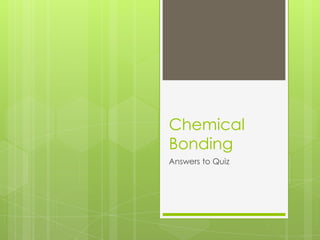
Chemical Bonding Quiz Answers Explained
- 1. Chemical Bonding Answers to Quiz
- 2. Question 1 Na melts at 98oC while K melts at 63oC. Sodium atoms are smaller than potassium atoms. Potassium has four energy levels while sodium has only three. Smaller atoms tend to form a more dense packing for the metals. This allows greater interaction among metal atoms, hence stronger metallic bonding for the smaller sodium than that of potassium. The stronger the metallic bond, the more difficult it is to separate them, hence Na melts at a higher temperature than K.
- 3. Question 2 Solid K conducts electricity while solid KCl does not. Electrical conductivity is possible if there are free particles that can carry the charge. Solid K metal is made up of metal atoms that give up their electrons to form a “sea of delocalized electrons” The presence of these “free” electrons is attributed to the metal’s ability to carry charge and hence conduct electricity. On the other hand, KCl is composed of K+ and Cl— ions bound by electrostatic forces in a crystal lattice. The ions here are not free to move, hence, KCl is not able to conduct electricity in the solid form.
- 4. Question 3 Solid iodine sublimes while ice melts when heated. Solid iodine is made of molecules arranged in a crystal lattice. Since I2 is nonpolar, the intermolecular force of attraction present is only London Dispersion Forces. LDF is a weak binding force. Relatively low energy is needed to break the interaction of the particles in the solid phase. Hence, I2, can be converted from solid to gas quite easily. On the hand, ice is composed of water molecules held by hydrogen bonding in a crystal lattice. Hydrogen bonding is a strong intermolecular force that relatively requires more energy than the LDF found between the I2 molecules. Ice will melt first before it is converted to a gas when heated.
- 6. Question 5 Phosphorus and nitrogen are expected to form similar compounds. PCl3 and PCl5 molecules exist whereas between NCl3 and NCl5, only NCl3 can be found in nature. Nitrogen and potassium are expected to form similar molecules since they belong to the same group and therefore contributes the same number of valence electrons. Phosphorus can form bonds with three or five chlorine atoms because it has empty 3d orbitals available when needed to accommodate more atoms as in the case of PCl5. On the other hand, nitrogen does not have a d-orbital it can use for bonding since nitrogen is in the second energy level. Hence, NCl5 molecule is not possible.
- 7. Question 6 SbCl3 has a measurable dipole moment, whereas SbCl5 does not. The molecular shapes of SbCl3 and SbCl5 are shown below. The Sb-Cl bond is polar due to the greater electronegativity of the Cl atom. In SbCl3, the electrons pairs are arranged in a trigonal pyramidal shaped wherein the dipole moments of the Sb-Cl bonds do not cancel. On the other hand, in SbCl5, the electron pairs are arranged in a trigonalbipyramidal shape. The molecule is symmetric; hence, the dipole moments cancel out. Thus, SbCl3 has a measurable dipole moment, whereas SbCl5 does not.
- 8. Question 7 BaO melts at 1923 °C while NaCl melts at 801°C Melting point depends on the strength of the lattice energy. The stronger the lattice energy between the ions, the greater energy is needed to convert the substance from solid to liquid. Lattice energy depends on (a) the charge of the ions and (b) the size of the ions as given by the formula. 𝐿𝑎𝑡𝑡𝑖𝑐𝑒 𝐸𝑛𝑒𝑟𝑔𝑦=𝑘|𝑞1𝑞2|𝑟 The charge of the ions has a more significant effect than the radius of the ion. BaO has a greater charge |𝑞1𝑞2|=4 while that of NaCl is |𝑞1𝑞2|=1. Since 𝐿𝐸 𝛼 |𝑞1𝑞2| , BaO melts at a higher temperature than NaCl
- 9. Question 8 Both diamond and graphite are made up of carbon atoms but only graphite can conduct electricity. Electrical conductivity is possible if there are free particles that can carry the charge. In diamond, each carbon atom is covalently bonded to four other carbon atoms in a tetrahedral structure. There are no free electrons in diamond that can carry the charge. In graphite, the carbon is covalently bonded only to three other carbon atoms forming a network of trigonal planar carbon structure. The fourth electron in each carbon is free and delocalized between the carbon layers. These delocalized electrons enable graphite to conduct electricity.
